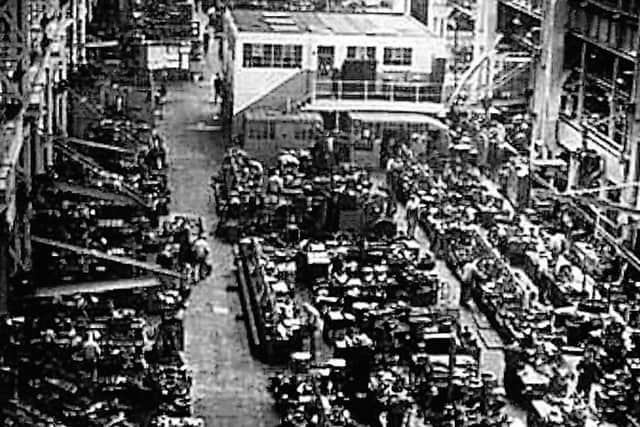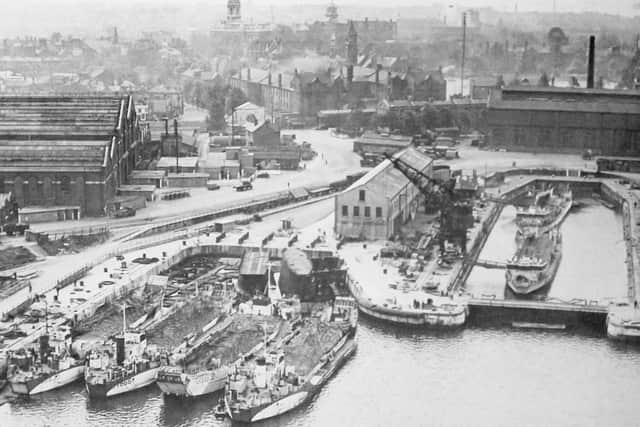Huge Portsmouth machine shop which kept the navy afloat '“Â Nostalgia


Ted Saunders, of Portchester, wrote saying that the building was the MED Factory, or Manager Engineering Department.
And he goes on to explain what went on in there.
He says: '˜There they repaired ships' engines and manufactured parts for all ships except gunnery stuff '“Â that was done in the Gun Shop opposite the power station.'


Advertisement
Hide AdAdvertisement
Hide AdTed adds: 'The railway locomotives [for the dockyard's own internal network] were repaired in the Engine Shed near East Gate and parts were probably made in the MED Factory if needed.
'˜The MED factory is the very long building you see when driving down the M275 into Portsmouth.
'˜It's 800ft long, and had lathes in there 100ft long so that propeller shafts could be machined. There were lathes with chucks 10ft in diameter to machine propellers.
 'Our Apprentices Training Centre was at the eastern end on the south side, so we had to walk past all this machinery to come and go.'
Advertisement
Hide AdAdvertisement
Hide AdTed continues: '˜In the original picture you can just see the camouflage on the roof. When I was working in there they renewed all the glass on the roof to get rid of the camouflage and let the light in. The picture was probably taken from the 250-ton crane.
 'You always had characters in the 'yard. One was an old shipwright who had no teeth. He always wore three coats and a bowler hat. When he came into the canteen he would spend time looking for his false teeth to eat his dinner with, going through all the pockets in all his coats.
 'When he found them he would put them on the table while he got his dinner, needless to say none of us apprentices wanted to sit next to him.
'˜Another chap held his top set of teeth in with his tongue even when he was talking. No one could understand a word he said and he got really wild if you laughed when he was talking.'
Advertisement
Hide AdAdvertisement
Hide AdRegular contributor Edwin Amey also confirms that the large building on the left was the MED Factory.
He says: '˜Here was repaired virtually all mechanical machinery (except weapons) taken from ships under refit.
'˜In 1949 when I started, there was in excess of 1,400 men in that one building.
'˜The two large bays were fitted with 40-ton overhead lift-travelling cranes and there were other, smaller versions.Â
Advertisement
Hide AdAdvertisement
Hide Ad 'The shed in the centre alongside the water was the old FAE (fitters afloat east) workshop, store and first floor canteen. The large building to the right rear was the boilershop for repair of ships' boilers.Â
 'Railway engines, cranes and all other associated dockyard machinery and plant was repaired by YSM (yard services manager) in their own workshops.'
'¢Â Yesterday being Trafalgar Day, I thought I would tell you about an incident encountered by Horatio Nelson in which, but for his agility, we might not have had him to lead the way at the Battle of Trafalgar.
In April 1784 Nelson wrote to a Captain Locker: '˜Yesterday, April 23, I was riding a blackguard horse that ran away with me at the Common.
Advertisement
Hide AdAdvertisement
Hide Ad'˜It carried me round all the works into Portsmouth by the London Gates through the town and out of the gate that leads to the Common.
'˜Here there was a wagon in the road which is so very narrow that a horse could barely pass.
'˜To save my legs, and perhaps my life, I was obliged to throw myself from the horse which I did with great agility but unluckily I fell on to hard stones which hurt my back and me leg but done no other mischief.
'˜It was a thousand to one that I was not killed.'
'¢ I published a photograph of Lumps Fort a week or so ago which prompted a reply from Jackie Baynes who contacted me about her book: The Story of Lumps Fort and Canoe Lake Park.
Advertisement
Hide AdAdvertisement
Hide AdIt covers Southsea Rose Garden, the Japanese Garden together with the Model Village '“ all of which sit within the walls of Lumps Fort.Â
Jackie says: '˜For anyone reading your pages, the winter period is the best time to seek out the remains of the fort because when the leaves come down the remaining features will be better revealed.'
Her book is available in St Thomas's Cathedral Shop, The City Museum Shop, Southsea Library Shop or mail order from Jackie on (023) 9283 1461.
It costs £4.95 and it would make a welcome Christmas gift to anyone who used to spend time in that area of Southsea or indeed newcomers to Southsea keen to find out more about the history of the seafront area.
Â